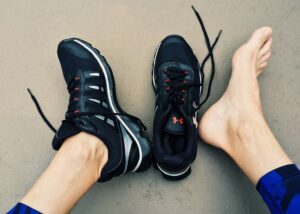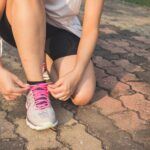The truth is, you can exercise no matter how much you weight. Whether you carry little or extra weight, you can modify your exercise accordingly, to meet your body’s needs.
It is also true however, that the more weight we have, the more stress we put in our feet. Research shows, that when we do regular walking, our feet are holding three to six times our body weight. So if we have for example 10 pounds of extra weight, our feet carry around 60 pounds of extra weight.

This means that if we lose even a little bit of weight, it will make a significant difference in the stress we put in our feet.
Next, I will share some tips that will help you deal with foot pain, especially if you are exercising with extra weight as well.
How important are the shoes we wear?
There is a lot of evidence that our shoes play a large role in the comfort and the health of our feet.
As a fitness expert, I am often asked: ‘I am going to buy gym shoes, what should I look for?’. My answer is, hold the shoe in your hand, and see if it bends easily, or if it is hard to bend. Comfortable shoes should bend with not too much effort. The other thing I always tell people, is to try it on and walk a few steps. If it doesn’t feel comfortable from the first time you try it on, then don’t buy it. Many times people think that it’s ok if the shoe feels a bit uncomfortable at the beginning because it is new and hasn’t taken the foot shape yet. Don’t do that. Make sure it feels comfortable from the beginning.
The other thing many people don’t know, and it happened to me as well, is that as we age, our shoe size might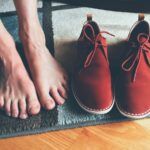 change. When I was younger, I was wearing a shoe size 37. After the birth of my children, I went to size 38. At first, I couldn’t accept it and was trying to fit into a size 37, which often left me with foot pain, until I realized and accepted that 38 would be my new size.
change. When I was younger, I was wearing a shoe size 37. After the birth of my children, I went to size 38. At first, I couldn’t accept it and was trying to fit into a size 37, which often left me with foot pain, until I realized and accepted that 38 would be my new size.
Two common reasons that usually lead to an increase in foot size are:
1. Weight gain. As we gain weight, we usually see our thighs and belly increasing is size. What we don’t usually realize is that our feet also increase in size because fat tissue increases there too. So keep in mind that weight gain can lead to increase in shoe size.
2. Plantar Fasciitis. This is a condition where as we age, the foot ligaments stretch, causing the arches to flatten, and this can lead to foot pain. The more weight we have, the more we increase the risk for this condition. This can also be caused by people who run or walk a lot, especially if they have extra weight.
So to lower the risk for Plantar Fascitis, it is recommended to choose a shoe that has arch support. Also, make sure there is some space (about 1cm), or the width of your finger, between the shoe and the end of the toe.
Another thing that might help you with foot pain is to use a foot support device or a heel pad. These might provide you with some relief from the pain since they put your feet in a more correct position.
Last thing we should do, and I don’t like this either because I get attached with my things, is to throw away your shoes as soon as they get worn. The sole of the shoe is what is important, because this is between your foot and the ground, and this is what is protecting your feet, not the top of the shoe, which is what we usually pay attention to.
Things You Can Do To Reduce Foot Pain
1. Lose weight. I know that for most people this might be very difficult, but extra weight really does play a big role in foot pain. As I said at the beginning, our feet are holding three to six times our body weight, so even a small weight loss, will give a big relief in our feet.
You don’t have to make it a big deal or too complicated. Just follow a few simple tips that will help you drop a few pounds. Tips like:
– Try to avoid processed food and include food that is closer to nature, for example a fresh apple coming from the apple tree, instead of packed dry apple full of preservatives found at the supermarket. You get the picture.
– Cook your meals and try to avoid ordering out. You don’t know what they put in your meal or in what way your meal was cooked. You might be getting a lot of extra calories that you didn’t know about. I know you might not have extra time with work, kids etc, but a good tip that helps me is to cook extra portion and keep it in the freezer, ready for whenever I don’t have time to cook.
– Avoid eating too late. Try to have your last meal not later than 7, and avoid binging after that. It might be a bit hard at the beginning but you get used to it. Also, it would be better to avoid carbs at dinner, or have a small portion of non processed carbs.
– When it is time for your sweet, (I know, mine is around 4 in the afternoon!) be prepared and have a few healthier alternatives. Instead of jumping in that chocolate, you could have some greek yogurt with honey and row nuts for example. Don’t try to cut back on sweets completely because after a couple of days you will make a big sweet comeback and you don’t want that.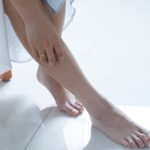
2. Raise the legs. Some of you, depending on the work you do, might be on your feet all day long. This not only leads to foot pain, but also to swollen legs. So even if you only have 5 minutes, lay down and raise your legs above the heart level. Your legs will be thanking you!
3. Use ice packs. Softly step on an ice pack to help you reduce swelling. Remember that you need to have a thin towel between your foot and the ice, or you might get frostbites.
4. Foot exercises. Doing some simple foot exercises will help strengthen the foot area so when you exercise you will not experience (or experience less) foot pain. Next you will find some foot exercises that you can do everyday.
Foot Exercises To Relief Foot Pain

Use these simple foot exercises everyday to help you strengthen your feet and to better maintain your feet’s health. These exercises will help you a lot especially if you carry extra weight, but it also helps elderly people to reduce the risk of falling.
– Place a towel on the floor and try to scrunch it with your toes.
– Flex and point your foot 10 times like a ballerina.
– Splay your toes, then relax and repeat.
– Sit and place a small ball, or a bottle, or rolling foam under your foot and roll.
– Calf raises. Stand on a step with your heels hanging outside the step. Hold with your hands somewhere for balance. Now let your heels slightly lower further than your toes, and then raise the heels up and go on your toes. Keep repeating the lowering and lifting of the heels for 10-20 repetitions. For elderly people they don’t need to go to a step. They can do the exercise on a flat surface for better balance.
– Standing calf stretch. Press your hands against a wall and step one foot back. Both feet should be facing forward, parallel. The back leg should be straight while the front leg slightly bend. You should feel the stretch on the calf of the back leg. For deeper calf stretch, from the same position slightly bend the back leg. Hold for 20 seconds and switch sides.
Types Of Exercises That Put Less Stress On The Feet
If you are experiencing foot pain but don’t want to stop exercising, then you can try exercises that put less stress on your feet. You might want to avoid for a while exercises like running, walking a big distance, or lifting too much weight. Instead, you can try: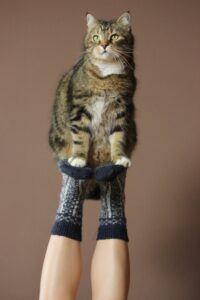
– Yoga
– Pilates
– Swimming
– Seated stationary bicycle
– Floor exercises
Conclusion
So there you have it. If you are experiencing foot pain, with or without extra weight, try to follow the above tips. They should help you find some relief and comfort on your feet, without sacrificing your love for exercise.
